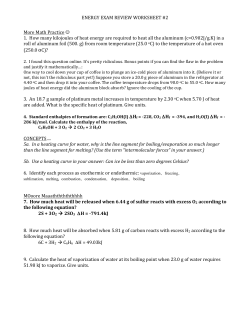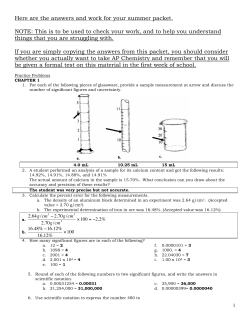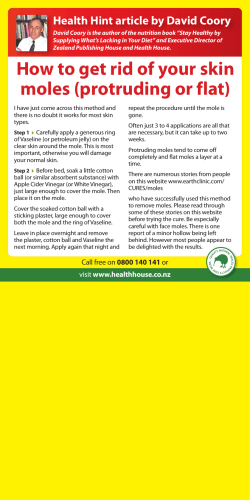
Name______________________________________ Student ID Number___________________________ Lab TA Name and Time_______________________
Name______________________________________ Student ID Number___________________________ Lab TA Name and Time_______________________ This is a sample Midterm #1 that I (Rolf Unterleitner) have made up for Dr. E’s sections of Chem 2A. The answers are at the end. I will go over the solutions Tue. the 28th starting at 5:40 PM-going about 2 hours in Chem 179. Please do not ask the Prof. or the TA's for the solutions they do not have them thank you. Instructions: 1. A B C D E 2. A B C D E 3. A B C D E (1) Read each question carefully. 4. A B C D E (2) There is no partial credit for the problems in Part I and Part II. 5. A B C D E 6. A B C D E 7. A B C D E 8. A B C D E 9. A B C D E 10. A B C D E 1–12. 36 points 11. A B C D E 13–14. 12 points 12. A B C D E 15–16. 16 points Bonus A C D CLOSED BOOK EXAM! No books, notes, or additional scrap paper are permitted. All information required is contained on the exam. Place all work in the space provided. If you require additional space, use the back of the exam. (3) The last page contains a periodic table and some useful information. You may remove this for easy access. (4) Graded exams will be returned in the discussion sections next week. (5) If you finish early, RECHECK YOUR ANSWERS! U.C. Davis is an Honor Institution Possible Points 17. 17 points 18. 10 points 19. 10 points Total Score (101) Multiple Choice (circle one) Points E B Exam I Page 2 of 11 Part I: Multiple Choice, Concepts Circle the correct answer here and on the cover – No partial credit (3 points each) 1. Cuperic ion and dichromate ion form what ionic compound? A. CuCrO4 B. Cu3(CrO4)2 C. Cu2(Cr2O7) D. CuCr2O7 E. CuCO3 2. The total numbers of neutrons, protons, and electrons in As that has a mass of 75.9967 u are: A. 43 neutrons, 33 protons, 33 electrons B. 33 neutrons, 43 protons, 44 electrons C. 43 neutrons, 33 protons, 34 electrons D. 43 neutrons, 33 protons, 32 electrons E. 42.9967 neutrons, 33 protons, 90 electrons 3. What is the mass of one mole of water (in u)? A. 0.18 B. 1.8 C. 18 D. 180 E. 1.1x1025 4. Chlorine is made up of two isotopes one has a mass number of 37 which of the following is likely to be the mass number of the other isotope of natural chlorine? A. 38 B. 36 C. 35 D. 28 E. 15 - Exam I Page 3 of 11 2+ 5. Complete the equation and indicate if a precipitate forms. Na+ + Br- + Hg2 + ClO3- → A. Hg2Br2(s) + Na+ + ClO3A. Hg22+ + 2 Br- + NaClO3(s) C. No reaction D. Hg2(ClO3)2(s) + Na+ + 2 BrE. 6. Hg2Br2(s) + NaClO3(s) Which of the following reactions is not an oxidation-reduction reaction? A . 3Cu(s) + 4 H+(aq) + 4NO3-(aq) → 3CuNO3(aq) + 2 H2O(l) + NO(g) B. CrO4-2(aq) + 3 Fe2+(aq) + 8 H+ → 3 Fe3+(aq) + Cr3+(aq) + 4 H2O(l) C. BrO3-(aq) + 3 HClO3(aq) → Br-(aq) + 3 HClO4(aq) D. Zn(OH)2(s) + 2 NaOH(aq) → Na2Zn(OH)4(aq) E. 2 C2H2(g) + 5 O2(g) → 4 CO2(g) + 2 H2O(l) 7. Consider the reaction between Gallium metal (Ga) and Fluorine gas (F2) to form Gallium fluoride. If 0.500 moles of Ga were mixed with 0.600 moles of F2 gas, which of the following statements is FALSE? A. The limiting reagent is F2. B. At the end of the reaction, there is leftover Ga. C. The theoretical yield of GaF3 is 0.500 moles. D. The theoretical yield of GaF3 is 0.400 moles. E. There would be .100 moles of Ga left over after the reaction is completed. 8. What is the average mass of one iron atom in u, and would any real atom of iron have that mass? A. 9.27 x 10-23, No B. 6.02 x 1023, Yes C. 1.08 x 1022, Yes D. 55.85, Yes E. 55.85, No Exam I Page 4 of 11 9. Magnesium is made up of three isotopes Mg-24, Mg-25 and Mg-26. If the % natural abundance of Mg-25 is 10.00% what is the percent of Mg-24? A. 10.5 B. 50.0 C. 79.5 D. 75.2 E. 20.6 10. Complete question #16B below. What type of reaction is described in that problem? A. Combustion B. Single Replacement C. Double Replacement D. Neutralization E. Decomposition 11. With mass spectral data the ratio of 11B/12C was found to be 0.9170 and the ratio of 35 Cl/11B is 3.180. According to the data, what is the mass of the 35Cl atom? A. 35 u B. 34.99 u C. 35.45 u D. 36 u E. 37 u 12. If a faucet is leaking slowly at a rate of 15 drops a minute and if there are 20 drops in one milliliter of water how long would it take to fill a 100 gal tub (1 galloon=3.785412L)? A. about one year B. about one month C. a couple of weeks D. a few days E. less than one day Bonus. If you saw a cow float by in the air which of the following would have to be true? A. The cow would have to have strong wings. B. C. D. E. The cow must have a very bad gas problem. The cow must be less dense than air. The cow must be denser than air. It’s time to wake up, class is almost over! Exam I Page 5 of 11 Part II: Short Answer Fill in the blank 13. (6 points) Matching: in the column marked “Answer,” fill in the statement number that best describes the item. Answer Item Thomson & Faraday Isotopes Becquerel & Roentgen 14. Statement – Which item is it? 1. These entities were determined to be very dense by Rutherford’s gold foil experiment. 2. These scientists worked with X-rays and radioactivity. 3. These entities will likely contain a metal. Ionic Compound 4. These entities may vary in the number of neutrons they contain. Coefficients 5. In a balanced chemical reaction, these entities will tell you the number of moles of each compound or the number of molecules of each compound. Nuclei 6. These scientists preformed experiments with the Cathode Ray Tube, leading to a mass-to-charge ratio and the Plum Pudding Model. (6 points) Provide the oxidation states for the elements indicated in the table. Compound fill-in the state sybol (a) Na2O2( ) (b) Al(ClO3) 3( (c) Hg( ) Provide the oxidation state here for the following elements O: ) Cl: Hg: Exam I Page 6 of 11 15. (8 points) Give the chemical formula or systematic name for the following. Spelling must be correct for full credit. A. CH3CH2CH2CHOHCH3 _________________________________________ B. PF5 ___________________________________________________________________ C. plumbous hydrogen dichromate ____________________________________________ D. hyposulfurous acid _______________________________________________________ E. hydrogenhyposulfite_______________________________________________________ F. 2,4-dimethlyheptane ______________________________________________________ G. octanoic acid ______________________________________________________ 16. (8 points total) Write the complete balanced chemical equation, and then the net ionic equation for the following reactions and give the state of each substance at normal laboratory conditions in parentheses. A. Solid aluminum reacting with hydrochloric acid. B. Stannic sulfate reacting with barium hydroxide. (Note: this is not a red/ox reaction) Exam I Page 7 of 11 Part III: Long Answer Please show all work – Partial credit – Use the correct number of significant figures 17. (17 points total) The stimulant in coffee and tea is caffeine, a substance of molar mass 194 g/mol. When 0.376 g of caffeine was burned (what a waste!), 0.682 g of CO2, 0.174 g of H2O, and 0.110 g of N2 were formed. A. (6 pts.) Determine the mass percent of each element in caffeine. %C: %H: %N: B. (4 pts.) Determine the empirical formula for caffeine. Empirical Formula: C. (1 pts.) Determine the molecular formula for caffeine Molecular Formula: %O: Exam I Page 8 of 11 18 (10 points total) Consider the following reaction: C3H8O(g) + ClO3-(aq) → CO2(g) + Cl2(g) A. Which is the element oxidized? B. Which is the element reduced? C. Write the oxidation reaction in acidic solution. D. Write the reduction reaction in acidic solution. E. Give the overall redox equation in basic solution. Exam I Page 9 of 11 19. (10 points total) Bottles of propane gas are sold in hardware stores as convenient heat sources. A. (1 pts.) Write the correct and balanced equation for the combustion of propane. B. (6 pts.) Using this reaction, calculate the mass of CO2 produced from the combustion of 2.35 g of propane in 1.56 g of oxygen gas (O2) if there was an 85.6% yield. Mass C CO2 (g) = C. (3 pts.) How many g of each reactant would remain once the reaction is complete? In this part assume a 100% yield. g O2 = g propane = Exam I Page 10 of 11 1) D 2) C 3) E 4) C 5) A 6) D 7) C 8) E 9) C 10) C 11) B 12) A 13) C 13) 6, 4, 2, 3, 5, 1 14) (a) (aq), -1 (b) (aq), +5 (c) (l), 0 15) A) 2-pentanol or pentan-2-ol B) phosphorus pentafluoride C) Pb(HCr2O7)2 D) H2SO2(aq) E) HSO2 F) (CH3)2CHCH2CH(CH3)(CH2)2CH3 or use bond line G) CH3(CH2)6COOH or use bond line. 16) A) 2Al(s) + 6HCl(aq) => 2AlCl3(aq) + 3H2(g) + 3+ 2Al(s) + 6H (aq) => 2Al (aq) + 3H2(g) B) A) Sn(SO4)2(aq) + 2Ba(OH)2(aq) => 2BaSO4(aq) + Sn(OH)4(s) 4+ Sn (aq) + 4OH (aq) => Sn(OH)4(s) 17) A) 49.5% C, 5.18% H, 29.3%N, 16.1%O B) C4H5N2O C) C8H10N4O2 18) A) ClO3 B) C3H8O + C) C3H8O(g) + 5 H2O(l) => 3 CO2(g) + 18 H (aq) + 18 e+ D) 2 ClO3 (aq) + 12 H (aq) + 10 e- => Cl2(g) + 6 H2O(l) E) 18 ClO3 (aq) + 5 C3H8O(g) => 9 Cl2(g) + 11 H2O(l) + 15 CO2(g) + 18 OH (aq) 19) A) C3H8(g) + 5 O2(g) => 3 CO2(g) + 4 H2O(l) B) 1.10 g CO2(g) C) 0 g O2(g) (b/c LR), 1.92 g C3H8(g)
© Copyright 2026





















